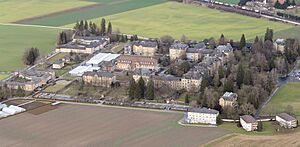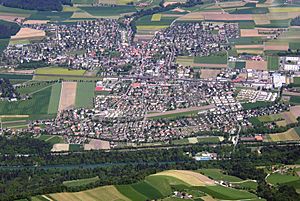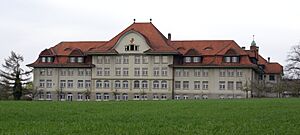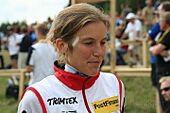Münsingen facts for kids
Quick facts for kids
Münsingen
|
||
|---|---|---|
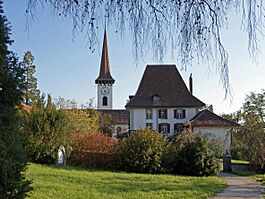
Münsingen rectory building
|
||
|
||
| Country | Switzerland | |
| Canton | Bern | |
| District | Bern-Mittelland | |
| Area | ||
| • Total | 15.77 km2 (6.09 sq mi) | |
| Elevation | 541 m (1,775 ft) | |
| Population
(Dec 2020 )
|
||
| • Total | 12,966 | |
| • Density | 822.19/km2 (2,129.5/sq mi) | |
| Postal code |
3110
|
|
| Surrounded by | Belp, Gerzensee, Konolfingen, Rubigen, Tägertschi, Trimstein, Wichtrach | |
| Twin towns | Humpolec (Czech Republic) | |
Münsingen is a town in Switzerland. It is located in the Bern-Mittelland area of the Bern canton. In 2013, the nearby town of Trimstein joined Münsingen. In 2017, Tägertschi also became part of Münsingen.
The town sits on the Aare River. It is found between the cities of Bern and Thun.
Contents
History of Münsingen
Münsingen began as a Celtic village around 400 BC. The name likely comes from the Alamanni people. Early villagers built about 220 tombs along the Aare river. Some men were buried with weapons. Women and children were buried with jewelry.
Archaeologists found 1,200 items from the village. These discoveries helped experts understand how to date ancient graves across Europe. The rich items in the graves suggest that important Celtic families lived in Münsingen. Two skulls found show signs of trepanation, which is a type of ancient brain surgery.
During the Roman era, a small settlement or country home existed near the current church. Parts of a wall and a bath house were found. The bath house floor had mosaics of fish and the god Oceanus. This bath house was likely built in the 2nd century AD.
Münsingen was first mentioned between 993 and 1010. King Rudolph III of Burgundy gave it to Count Kuno. The town then belonged to the Kyburgs and the Zähringens. In the 13th and 14th centuries, the Senn knights took control. The town's current coat of arms comes from this family.
In 1377, the last Senn family member sold the town to a rich family in Bern. Over time, the city of Bern slowly gained all rights to Münsingen. Münsingen was an important meeting place during the German Peasants' War. It played a big role in Bern's history as people fought for more democracy.
Münsingen Castles and Buildings
The town was first ruled from a castle on a hill above the Müli valley. Not much is known about this old building. By the 12th century, a new castle was built in Münsingen town. The Senn family ruled from this castle. However, Bern destroyed it in 1311.
A wooden building was built on the castle land in 1314. In 1550, a leader named Hans Franz Nägeli rebuilt the castle. It was later fixed up between 1749 and 1753. In 1977, the town bought the castle and made it a museum.
The wooden building was rebuilt in 1570 into a country house. In 1877, the Bern canton bought it. They turned it into a special clinic for mental health. This clinic was important in the 1930s for new treatments in psychiatry.
Geography of Münsingen
Münsingen covers an area of about 8.5 square kilometers (3.3 square miles). About 46.8% of this land is used for farming. Forests cover 17.1% of the area. Buildings and roads make up 35.1% of the town. Rivers and lakes cover 1.4%, and a small part (0.2%) is unproductive land.
The town is in the Aare valley. It includes the village of Münsingen and the canton's psychiatric clinic.
Coat of Arms
The blazon of Münsingen's coat of arms is simple. It shows a red shield with a silver stripe at the top and a silver stripe down the middle.
Population and People
Münsingen has a population of about 11,355 people (as of December 2011). In 2010, about 9.2% of the people living there were from other countries.
Most people in Münsingen speak German. About 92.9% speak German as their first language. Italian is the second most common language, spoken by 1.5% of the people. French is third, spoken by 1.1%.
In 2008, about 47.8% of the population was male and 52.2% was female. About 24.3% of the people living in Münsingen in 2000 were born there. Many others were born in the same canton (44.8%) or elsewhere in Switzerland (15.7%). About 10.7% were born outside Switzerland.
In 2011, children and teenagers (0–19 years old) made up 20.4% of the population. Adults (20–64 years old) were 58.4%, and seniors (over 64 years old) were 21.2%.
The number of people living in Münsingen has grown over time, as shown in the chart below:

Important Buildings and Sites
Several buildings in Münsingen are listed as important Swiss heritage sites. These include the Münsingen Clinic Building, the village rectory (a church house), and the USM factory and offices. The area around the Münsingen Clinic is also a protected heritage site.
Main Sights to See
- Münsingen Castle
- Landwirtschaftliche Schule Schwand (the former Schwand Agricultural School)
How Münsingen is Governed
Münsingen is run by a council with seven members. It also has a municipal assembly with 30 seats.
Religion in Münsingen
Based on a 2000 survey, most people in Münsingen (68.2%) belong to the Swiss Reformed Church. About 13.5% are Roman Catholic. Smaller numbers of people belong to other Christian churches, or are Islamic, Buddhist, or Hindu. About 6.28% of the population said they did not belong to any church.
Economy and Jobs
Münsingen's most important company is USM. This company is famous worldwide for making office furniture.
In 2011, Münsingen had a low unemployment rate of 1.8%. In 2008, there were 5,778 people working in the town. Most jobs were in the service industry (like shops, hospitals, and schools). Many others worked in the manufacturing and construction industries. A small number of people worked in agriculture.
Many people who live in Münsingen also work there. However, more people leave Münsingen to work elsewhere than those who come into the town for work. About 31.7% of working people used public transport to get to work. About 38.1% used a private car.
Education in Münsingen
Münsingen offers many levels of education. These include primary school, middle school, and secondary schools. There are also options for higher education.
The school system in Bern canton starts with one year of optional Kindergarten. Then, students attend six years of Primary school. After that, there are three years of required lower Secondary school. Students are placed into different classes based on their skills. After lower Secondary, students can continue their schooling or start an apprenticeship (on-the-job training).
In the 2010–11 school year, 1,341 students attended schools in Münsingen. This included 177 kindergarten students and 682 primary school students. There were also 454 students in lower secondary classes.
Sports
FC Münsingen is the town's football (soccer) club.
Twin Towns
Münsingen is connected with another town:
 Humpolec, Czech Republic
Humpolec, Czech Republic
Notable People from Münsingen
- Christian Müller (1921–2013) was a Swiss psychiatrist and writer.
- Simone Niggli-Luder (born 1978) is a Swiss orienteering athlete who lives in Münsingen.
- Roman Bürki (born 1990) is a Swiss professional football player.
- Nora von Bergen (born 1990) is a Swiss ice dancer.
- Patric Niederhauser (born 1991) is a professional racing car driver.
- Michael Frey (born 1994) is a Swiss football player.
- Reto Keller (born 1994) is a Swiss curler.
See also
 In Spanish: Münsingen para niños
In Spanish: Münsingen para niños





